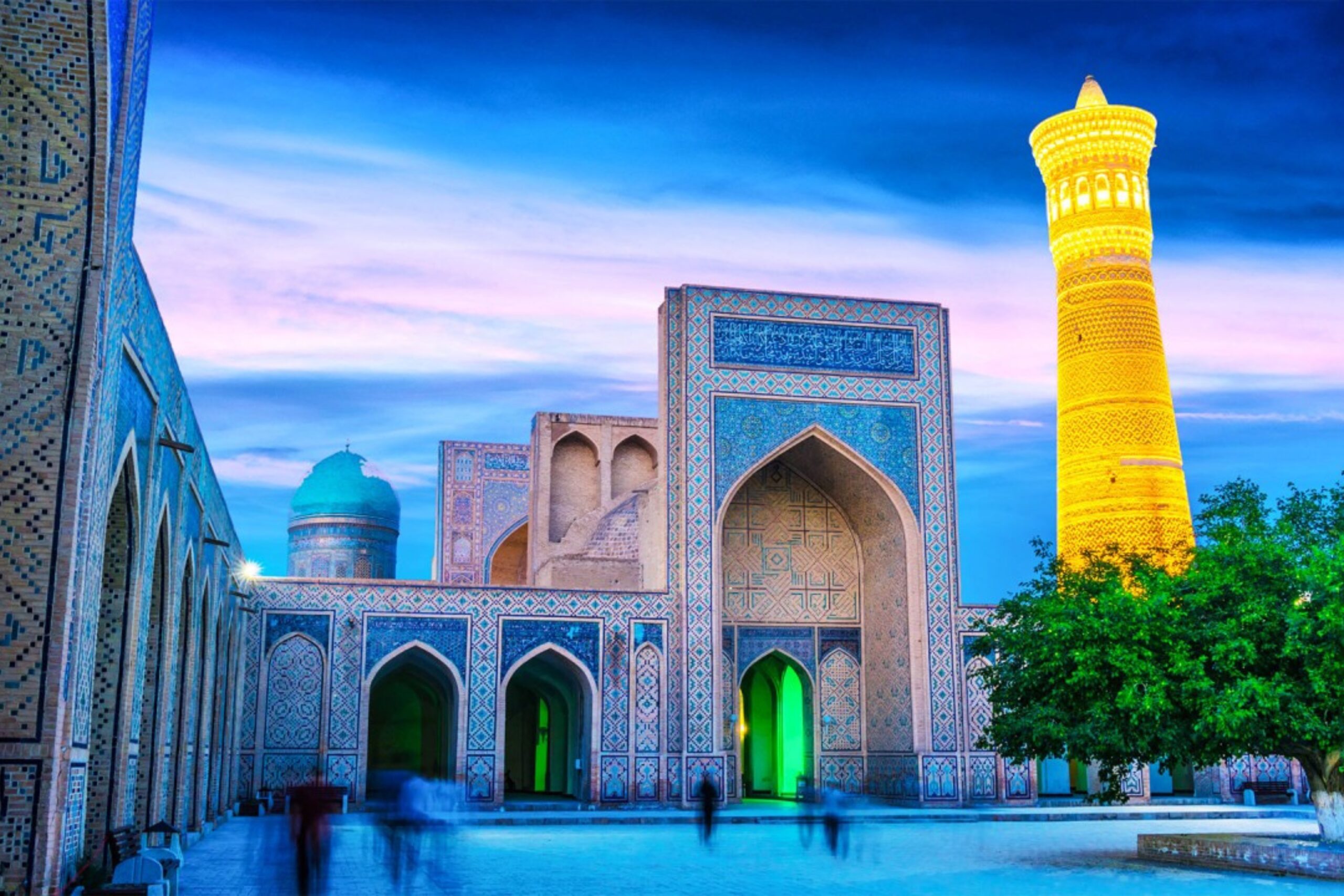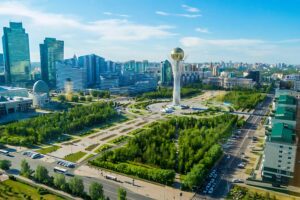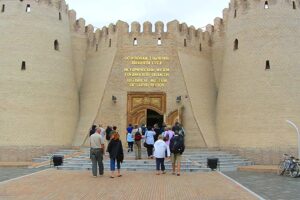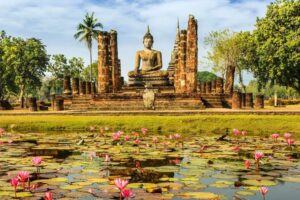Uzbekistan is a country of great historical and cultural significance, rich in ancient architecture, vibrant bazaars, and breathtaking landscapes. As the heart of the ancient Silk Road, Uzbekistan offers travelers a chance to explore some of the most well-preserved sites from centuries past, along with a unique blend of Central Asian traditions. Here are some of the best places to visit in Uzbekistan:
1. Samarkand
Registan Square: Arguably Uzbekistan’s most iconic landmark, Registan is a stunning public square surrounded by three majestic madrasas (Islamic schools). The intricate tilework and towering minarets make it one of the most remarkable architectural ensembles in the world.
Shah-i-Zinda: A breathtaking necropolis, this complex is home to the tombs of prominent historical figures, including the cousin of the Prophet Muhammad, Kusam ibn Abbas. The mausoleums are known for their vibrant blue tile decorations.
Gur-e-Amir Mausoleum: The tomb of Tamerlane (Timur), the founder of the Timurid Empire, is an impressive example of Persian and Central Asian architecture, with its massive dome and intricate designs.
Bibi-Khanym Mosque: Once one of the largest mosques in the Islamic world, Bibi-Khanym is an awe-inspiring site, though much of it has been restored after centuries of wear. It was built by Timur in honor of his wife.
Ulugh Beg Observatory: Built by the astronomer Ulugh Beg, this site houses the ruins of a 15th-century observatory and gives insight into the advanced astronomy of the Timurid era.
2. Bukhara
Historic Centre of Bukhara: A UNESCO World Heritage Site, Bukhara is one of Central Asia’s most well-preserved medieval cities, with over 140 architectural monuments. Key highlights include the Ark Fortress, Bolo Haouz Mosque, and the Kalon Minaret.
Samanid Mausoleum: This 9th-century mausoleum is one of the oldest examples of Islamic architecture in Central Asia, known for its exquisite brickwork and design.
Lyabi-Hauz Complex: A serene square surrounded by historical buildings, including the Kukeldash Madrasa and Nadir Divan-Begi Madrasa, with a peaceful pond in the center.
Trading Domes: Bukhara was a significant trading hub on the Silk Road, and you can still visit the covered caravanserais and market domes, such as the Toki Zargaron and Toki Telpak Furushon.
Chor Minor: A picturesque structure with four minarets, built as part of a madrasa, offering a unique and photogenic view of the city.
3. Khiva
Itchan Kala: The historic inner town of Khiva, a UNESCO World Heritage Site, is a well-preserved example of a Silk Road city. Its maze of narrow alleys, impressive gates, and monumental buildings evoke the grandeur of ancient Khorezm.
Juma Mosque: A mosque with 218 wooden columns, which has an interesting mix of local and Islamic architecture.
Kalta Minor Minaret: Known for its massive size and vibrant blue tiles, this minaret was originally intended to be even taller than it is today.
Pahlavan Mahmud Mausoleum: This striking mausoleum honors the famous poet and wrestler Pahlavan Mahmud, featuring stunning turquoise tiles and intricate decoration.
Kunya Ark: The historic citadel, once the residence of the khans of Khiva, offers a glimpse into the city’s royal history and architectural beauty.
4. Tashkent
Khast Imam Complex: A major religious center in Tashkent, home to the Uthman Quran, believed to be the oldest surviving Quran in the world. The complex includes several historic buildings, such as the Barak-Khan Madrasa and Tilla Sheikh Mosque.
Independence Square: Tashkent’s main public square, lined with fountains, monuments, and trees, is a central gathering place in the city. It is the site of several significant national landmarks.
Chorsu Bazaar: A vibrant and colorful market that offers everything from spices and fresh produce to traditional handicrafts. It’s one of the best places to experience local Uzbek culture.
Tashkent Metro: Uzbekistan’s capital boasts an elegant and architecturally unique metro system, with each station featuring beautiful mosaics, chandeliers, and intricate designs.
Amir Timur Square: A tribute to the great conqueror Tamerlane (Timur), the square features an equestrian statue of the ruler surrounded by grand architecture.
5. Shahrisabz
Ak-Saray Palace: The ruins of the once magnificent palace of Tamerlane stand as a testament to his grand ambitions. The imposing entrance, with its intricate brickwork, still impresses visitors.
Dor-us-Siadat Complex: A historical site featuring the mausoleum of Tamerlane’s father, Tariq ibn Ziyad, and the remains of a large mosque, offering a glimpse into the region’s rich history.
Shamsiddin Kulal Mausoleum: The tomb of a revered Sufi saint, this mausoleum is known for its unique architectural style and peaceful atmosphere.
6. Fergana Valley
Margilan: Known for its centuries-old silk production, Margilan is a great place to explore the traditional processes behind the famous Fergana silk. Visit the Yodgorlik Silk Factory to see artisans at work.
Kokand: A historic city once home to the powerful Kokand Khanate, it features the Khudoyar Khan Palace and several beautiful mosques and madrassas.
Andijan: Known as the birthplace of the great reformer and ruler Babur, the founder of the Mughal Empire in India, Andijan is home to several historical sites, including the Babur House Museum.
7. Nukus
State Museum of Art: This museum houses one of the world’s largest collections of Russian avant-garde art outside of Russia, as well as Uzbek and regional artworks. The collection includes pieces by famous artists such as Marc Chagall and Kandinsky.
Muzey Zheleznyak: A fascinating museum dedicated to the history and culture of the region, particularly the Aral Sea disaster and the legacy of the Khorezmian civilization.
8. Aral Sea (Muynak)
Muynak: Once a thriving port city on the Aral Sea, Muynak is now a haunting ghost town, with the Aral Sea’s receding waters leaving behind rusted ships stranded far from the shore. This stark and surreal location serves as a reminder of the environmental catastrophe caused by Soviet-era irrigation projects.
9. Nisa (Ancient Merv)
Located near the Turkmenistan border, this ancient site is the ruins of a Parthian city once a major stop on the Silk Road. It features ancient temples, residential areas, and burial sites.
10. Boysun
A small town in southern Uzbekistan, Boysun is renowned for its well-preserved traditional culture and crafts. The region is also a UNESCO World Heritage Site, and visitors can explore traditional homes, local handicrafts, and ancient petroglyphs in the surrounding hills.
11. The Kyzylkum Desert
Kyzylkum Desert: The vast, arid expanse of desert offers a chance to explore the country’s more remote and rugged regions. Visitors can take camel rides, visit desert forts, or simply enjoy the quiet solitude of this dramatic landscape.
12. Charvak Reservoir
Located in the Tian Shan Mountains, Charvak Reservoir is a popular getaway for both locals and tourists, offering picturesque views, hiking, swimming, and boating opportunities. The surrounding mountains provide a beautiful backdrop for relaxation.
Uzbekistan is a country rich in history, culture, and natural beauty, offering an eclectic mix of architectural wonders, historical sites, and scenic landscapes. Whether you’re exploring the ancient Silk Road cities of Samarkand and Bukhara, marveling at the ancient desert ruins of Khiva, or immersing yourself in the rich local traditions, Uzbekistan offers a fascinating journey through time.







